Bron Willis dives into the challenge and the triumph of learning to ride and how to plan bike trips the whole family will enjoy.
You’re eager to launch into family riding, but when will your little one be ready for outings in the child seat or trailer? And when will junior have enough balance to present them with their first bike for Christmas? Ride On has some tips on what to expect from your little Cadel Evans throughout the tender years of childhood.
For advice we turned to Ted Wilson, a bicycle education guru for 25 years. His company, Wilcare Services, remains the Department of Education and Early Childhood Development’s (DEECD) preferred provider of instructor accreditation for the Bike Ed program in Victoria.
Wilson says the key to helping children develop their bike riding skills is to have fun. “If it’s enjoyable for kids, they’ll develop well. But if they’re pushed too hard, too soon – if they get scared off – they won’t develop.” Wilson hastens to add that every child is different. “Really, it’s an individual thing. Every child is different – it’s just like ball play. Some will take to it very quickly, and some won’t. Don’t compare what your oldest did at a certain age, with what your youngest isn’t doing now.” Use any tips you read (including the ones in this article) as a guide and don’t worry if things happen a little more slowly. Even Cadel had to learn balance before he won the Tour de France.
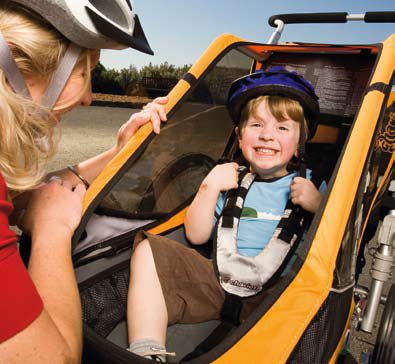
Trailers and child seats
If you’re a parent, you won’t need to be told that a newborn baby’s control of their body is minimal. After around their first birthday they will begin to develop better muscle control and will be able to hold their head up on their own. Once they have developed this muscle strength, you might feel brave enough to venture out on a sunny afternoon and, together with your junior team member as passenger, take on the local bike path. There are a myriad of front and back child carriers, plus kiddie trailers to choose from, all with their pros and cons.
Tricycles and pedal-less bikes
In the months after this initial tremulous adventure together, your 12- to 24-month old will likely just be your one-man-support-team and source of entertainment whilst out on riding expeditions to the local shop and back. But soon enough, they’ll be ready to brave the unknown challenges of your backyard on their first wheeled machine. The humble tricycle is custom-made for kiddie fun, and is a great first step.
Tricycles teach the basic skills of pedalling and steering. They are the perfect tool to encourage the development of your child’s coordination. US bicycle guru Sheldon Brown went so far as to say, “Ideally, a child should get a tricycle even before he or she learns to walk.” (www.sheldonbrown.com/teachride.html) Others suggest that four is a good age by which children might be able to start and stop a tricycle.
Ted Wilson is also a big fan of tricycles as a first step. “Trikes are great for teaching kids pedalling and steering. They’re good because of the stability they offer, and because they teach kids the momentum of getting both pedals going.” Scooters and pedal-less bicycles are other alternatives to tricycles.
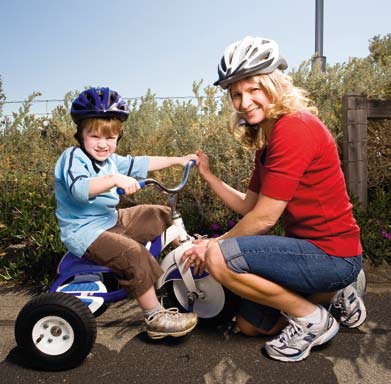 Trainer wheels
Trainer wheels
While trainer wheels might give your little tacker some assurance during a stage which can be fairly intimidating, Ted Wilson is not a fan: “Kids become dependant on trainer wheels, as they get used to the lean of the bicycle to one way or the other. I think they can impede the natural development of the child.”
David Salamy, a parent and Bicycle Network member, found a different way to teach his children balance while riding: “My three children didn’t really like trainer wheels, so progressed to riding with assistance – I would give them a gentle push to get them rolling and stay upright with me running behind the bike holding the back of the seat.”
Feisty four and fiery five
By the time your child is four, they might be ready to take on the challenge of learning balance. If you think your child is ready for their first two-wheeled riding experience, start with 16-inch wheels (or an equivalent frame size), and back-pedal brakes. Pedal brakes allow children to concentrate on pedalling, balancing and steering the bike, without the worry of co-ordinating handbrakes at the same time.
Wilson advises on using a bicycle without pedals: “Remove the pedals and lower the seat so the child can sit on the seat with both feet flat on the ground.” From here, children can walk the bike whilst sitting on the seat, increase the walking speed and then move onto a coasting or scooting motion. When they’re ready, they can pick up the speed. Wilson suggests you can also set up a slalom-style course to develop skills in steering.
Your backyard might be getting a little small at this stage; if your child is confident, this might be the moment you’ve been waiting for: head to your local park or bike path, picking a quiet time of day when there are fewer pedestrians, dogs, other bike riders or general traffic around. Being in a park allows your child to stretch their legs a little and gain confidence in stopping, starting, pedalling and turning. A gentle slope may be helpful, but make sure the support team is close by to avoid bruises and tears – that’s you!
At the age of five, most children are not yet ready to tackle handbrakes and gears.
With the beginnings of ability with balance established, you might choose a tag-along. Ride On has reviewed different models and their pros and cons.
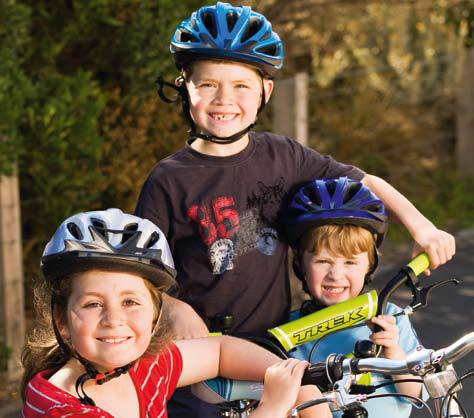 Six to eight and beyond
Six to eight and beyond
Your little one might not be so little now! And as they grow, their bike will need to grow too; most eight-year olds should be ready for 20-inch wheels (or an equivalent frame size). Wilson emphasises though, that “kids don’t grow into bikes!” Sheldon Brown agrees. “The ideal bike for learning to ride, whether for a child or a deprived adult, is a bike that is ‘too small’ for efficient riding.” The common misconception, that bikes – like hand-me-down clothes – should be bought big enough to accommodate a child’s future growth will only make the learning stages more difficult.
Your protégé might be showing some promising signs of future glory by now! Or of course, s/he might be just learning to love the sensation of being on a bike, which is the best that a parent can hope for. This is the stage to try using gears. Wilson advises “From my observations 8–9 years is about the age when they will be able to use the gears to some effect and benefit from some simple instruction.”
As a parent, you can play an important role in encouraging their riding habits, by offering them a variety of places to ride and leading by example; showing them that riding your bike is just a normal part of daily life will encourage lifelong habits. Holidays are also an opportunity to explore by bike; rail trails, for instance, are a good way to introduce them to sharing space with other path users, in preparation for taking them onto roads.
In most Australian states, children are allowed to ride on the footpath up until the age of twelve. In their guide Becoming a safe road user, VicRoads recommends that “children under 9 years of age do not ride on the road without adult supervision. They still have to develop the understanding, skills and experience to cope with traffic.” After your children turn twelve, they are no longer allowed to ride on the footpath in Victoria; teaching them road safety before this age is essential.
Bicycle Network is campaigning for laws to change to allow children to ride on the footpath up to the age of 16 throughout Australia. Read more about this issue and how you can support the campaign at Raise Ages – Ride Footpaths.
This is perhaps the most challenging stage for parents. Wilson encourages plenty of supervision. “Ride with them and lead by example. Following on close behind is the best way to supervise, rather than Mother Duck and the ducklings. Riding closely behind is the best way to stay in control – you can see what they’re doing, and you can talk to them as you ride.”
This might also be the time to do some formal bike education training. Many secondary schools run Bike Ed programs, teaching children how to interact with traffic, and to indicate their intentions clearly, with other road users.
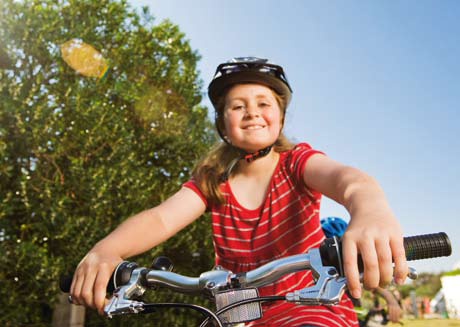 How far, how soon?
How far, how soon?
Many parents ask the question: “How far will my nine-year old be able to ride?” Or, “Is my twelve-year old up to riding in a Great Victorian Bike Ride?” Perhaps the best person to ask this question to is your child themselves – like any skill, children vary greatly in their abilities and stamina, depending on their riding experience, stamina, and of course their own motivation.
Margaret Taft, a Bicycle Network member from Castlemaine, Victoria, agrees that children develop at their own pace. “My grandson Riley rides with us often. At the age of five he was the only child to join a group of adults in an organised ride day in Castlemaine. He rode fourteen kilometres.”
Wilson suggests taking children on rides of increasing distances and seeing how they go. “Many kids would surprise their parents about how far they can ride,” he says. “It’s amazing how their little legs pound away. I’ve seen nine- and ten-year old kids ride 70km in a day, and the first thing they wanted to do when they got to the end was jump on their bikes and go and play.”
Andrew Smalley, Bicycle Network member from East Brunswick, Melbourne, can testify. “My son Felix got a second-hand mountain bike at 11, and when we went to Lysterfield Park for the first time, he left me behind! But he kindly waited for me to catch up every so often!”
Whatever their potential, your encouragement as parents is possibly the most essential tool to get your young one on their bike. Have as much fun as you can, after all, your child will only be young once!
Photography by Richard Jupe.
This article was first published in 2009 but with a few updates the wisdom shines through and it dusts off well for today.
Here’s a personal account of a meandering journey of teaching a child to ride, with links to alternative methods and other testimonies.
Ride On content is editorially independent, but is supported financially by members of Bicycle Network. If you enjoy our articles and want to support the future publication of high-quality content, please consider helping out by becoming a member.

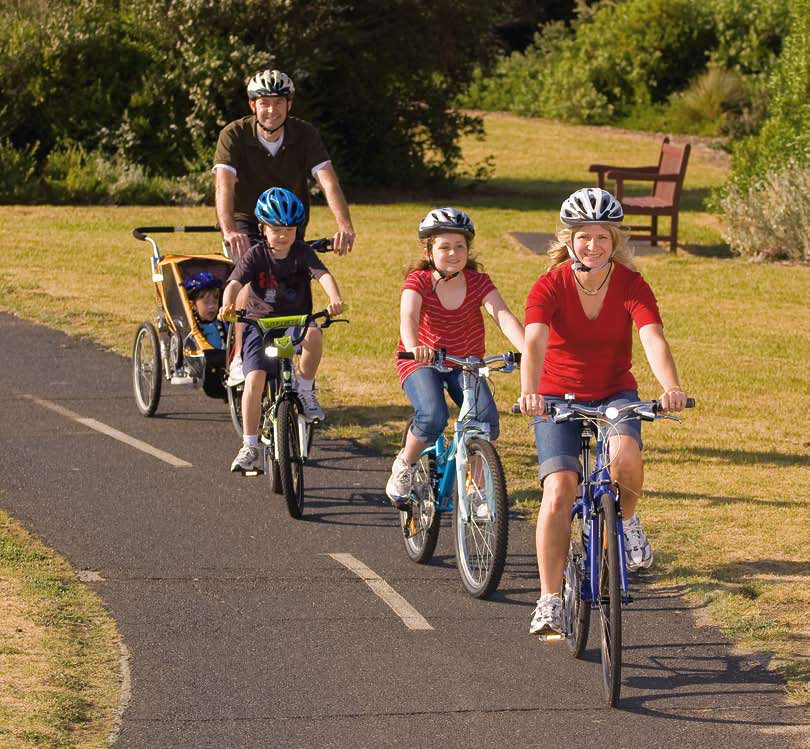
Been a few years when mine were that small.
Yep trainer wheels are just a short term thing to get some idea of balance.
The back of the seat trick is the best way. Sometimes they can get too confident just like us adults. So best to keep an eye out.
My oldest tried to turn into the driveway too quick from the footpath. She went one side of the letterbox , the bike went the other. Luckily no major harm done.